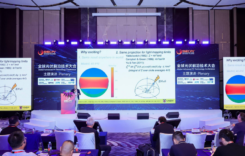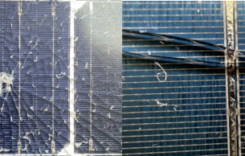PVTIME – Renshine Solar and a research team from Nanjing University have announced a major breakthrough in all-perovskite tandem solar cells. The devices have achieved a conversion efficiency of 30.1% certified by Japan’s Electrical Safety and Environment Technology Laboratories (JET). This is the first time any polycrystalline thin-film solar cell has exceeded 30% efficiency. The result has been included in Solar Cell Efficiency Tables (Version 66) and the team published their findings in the main journal of Nature on 27 October 2025.

All-perovskite tandem solar cells lead the development of next-generation photovoltaic technology. By combining wide-bandgap and narrow-bandgap perovskite materials they hold potential for unprecedented power conversion efficiency (PCE). Their full capabilities have long been limited by material and interface challenges however. The most critical issue lies at the buried interface between the hole transport layer (HTL) and narrow-bandgap (NBG) perovskite sub-cell. This interface acts as a key bottleneck because non-radiative recombination losses significantly restrict device performance.
The research team’s key solution is a new dipole passivation strategy. This approach not only suppresses interface trap states but also precisely adjusts energy level alignment at the HTL-perovskite junction. By boosting charge extraction while reducing unnecessary recombination it fundamentally improves interface properties. This creates a new path to better efficiency and stability for lead-tin (Pb-Sn) based NBG perovskite cells which are core to high-performance all-perovskite tandem devices.
Minimizing non-radiative recombination at the HTL-perovskite interface in Pb-Sn mixed perovskites has long been difficult. Traditional passivation methods used long-chain amine molecules. These molecules formed insulating layers that hindered charge transport. While such methods reduced trap states they inadvertently damaged fill factor (FF) and short-circuit current density (Jsc). This limited output power and efficiency. Achieving a balance between effective passivation and efficient charge extraction remained elusive until this new strategy was developed.
The dipole passivation method uses molecular dipoles to regulate the interface’s electrostatic environment. The team deposited an ultra-thin dipole layer to induce favorable energy level alignment. This created an ohmic contact between the perovskite and HTL. The structure greatly improves hole injection efficiency while repelling electrons. This suppresses recombination at the interface and overcomes long-standing material limitations.
A notable outcome of the strategy is a significant extension of carrier diffusion length in the Pb-Sn perovskite layer. The length reaches 6.2 micrometers. Longer diffusion lengths prevent premature recombination of photo-generated carriers as they move through the perovskite absorption layer. This maximizes current extraction efficiency and device performance by ensuring more charge carriers contribute to electricity output.
In performance tests Pb-Sn perovskite single-junction devices treated with the strategy achieved a PCE of 24.9% and an open-circuit voltage (Voc) of 0.911V. This is a strong improvement given the inherent challenges of Pb-Sn perovskite fabrication. These devices also showed a high Jsc of 33.1mA/cm² and an excellent FF of 82.6%. These figures confirm superior charge collection dynamics from the passivated interface.
For all-perovskite tandem cells the dipole passivation technology effectively suppresses contact losses. These losses are caused by the interconnect layer linking wide-bandgap and narrow-bandgap sub-cells. These interface modifications allow the tandem device to reach a PCE of 30.6% under standard testing conditions. Its certified stable efficiency is 30.1%.
This efficiency milestone positions all-perovskite tandem cells as strong candidates for next-generation photovoltaic technology. They outperform many existing options in both performance and material sustainability. The research not only solves interface recombination issues but also demonstrates how molecular engineering at buried interfaces can boost device performance without compromising stability or manufacturability.
The study integrates molecular chemistry materials science and device engineering. It highlights the role of interface science in renewable energy innovation. It opens a new chapter in perovskite solar cell research where precise interface regulation is as important as the bulk optoelectronic properties of absorption layer materials. These advances are expected to accelerate the commercialization of all-perovskite tandem technology reduce costs and expand its global application.
Given the scalability of the dipole passivation process integrating it into existing perovskite device manufacturing workflows is feasible. This adaptability is critical for turning lab-scale breakthroughs into industrial production. It also drives the deployment of high-efficiency tandem modules in real-world solar installations.
The reported results come from detailed experimental research and advanced characterisation techniques. These efforts uncovered and optimized molecular dipole effects at buried interfaces. They emphasize the importance of understanding interface phenomena and suggest future performance gains will likely come from intelligent chemical and physical passivation solutions.
The photovoltaic sector is working toward the 35% efficiency target for tandem solar cells. Insights from this dipole passivation research provide a clear path to reach this goal. By addressing one of the most stubborn loss issues in narrow-bandgap sub-cells the method paves the way for perovskite tandem devices to reach previously unattainable efficiencies. This heralds a new era of high-efficiency scalable solar energy use.
In summary the innovative dipole passivation method offers a transformative solution to interface-related recombination losses in Pb-Sn perovskite solar cells. Its profound impact on charge carrier dynamics energy level alignment and overall device performance marks a major breakthrough in perovskite photovoltaics. This achievement deepens understanding of buried interface physics and brings the vision of high-efficiency all-perovskite tandem technology closer to reality.

Scan the QR code to follow PVTIME official account on Wechat for latest news on PV+ES











